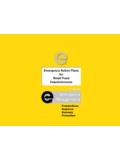Transcription of 0843 2898528 or 0782 5511877 (Mobile) - Action …
1 Action R/C ElectronicsDrawn by Dave MilbournSCHEMATIC OF INSTALLATION IN TWIN-ENGINED MODELType: Dual ESC and Mixer Module. Equivalent to two fully operational ESCs and a mixer, all in the same case. Will suit most types of DC brushed motor used in model boats, including 7+ pole of channels required: 2 Motor voltage: 6v to 24v Maximum continuous current rating: 20A per ESC (P94 Lite = 10A per ESC)Modes: 4 different modes of operation, selectable by user via on-board 2-way DIL switches: Mode 1: Dual electronic speed controllers - Each ESC works from a separate channel Tank Steering ;Mode 2: Dual thruster mode - Controls bow and stern thrusters. Skipper selects either Traverse (where thrusters work in the same direction and slew the model sideways) or Spin (where the thrusters work in opposite directions and spin the model on its own axis).
2 Selection is done by blipping the rudder stick hard over and letting it go straight away. Both thrusters are also fully speed-controlled. Mode 3: 0% - 100% Mixer. As Mode 4, except that inboard motor can be made to spin at full speed in reverse sense on full rudder command you can spin the model on its 4: 0% - 50% Mixer. Applies differential speed control to the motors automatically as a rudder command is give. Adjustable from 0%, where there is no mixing of rudder and throttle signals, up to 50%, where the inboard motor just stops at full rudder command. Other ESCs shut down motors on loss of Motor & Rudder headers provided for connecting the steering servo and aP94 automatically sets neutral position of throttle and steeringseparate speed controller to operate a centre powering up No binding or other setting up to doAdjustable thruster the operation of commercial thrusters from higher-voltage main DUAL ESC/MIXER MULTI CONTROLLERCase Dimensions (approx)28305074ON12TH1TB2TB1R1H2 Mode SwitchSCH1CH2 BATTRx power packReceiver Steering ServoESC for motor onStb d MotorMain batteryMain batteryPort Motorcentre shaft (if required)(2 Channel Minimum)No heat-sinks on P94 Lite0843 2898528 or 0782 5511877 ( mobile )P94 Dual ESC/Mixer Multi-controllerInstalling the P94 Important!
3 Because of the high power of the P94 Multi-controller, care should be paid to the installation of the unit. Each ESC circuit can deliver 20A continuously (P94 Lite 10A) and the wiring installation should be designed with that in mind. The unit has two positive supplies and two ground connections. When installing the system, it is very important to remember that the two ESC circuits within the P94 are not separate units and must be treated as a single entity. Do not under any circumstances connect a separate battery pack to each pair of red and black wires - it may seem logical but you will very probably do fatal damage to the P94!Fig #4 shows a basic installation. The two grounds (black) wires must be connected together. The length of wire must be kept to an absolute minimum. Similarly, the positive (red) wires should be connected together and kept as short as possible.
4 The wires should be joined close to the fuse-holder which is then connected to the battery. The fuse must be sized to be as small as possible without causing nuisance tripping. A 40A fuse, maximum, should be used to protect the unit (P94 Lite 20A). FIG#5 shows a more convenient way of connecting and fusing the P94 by using a P92 Power Distribution Board. P102 can be used where there are three motors more than one battery is being used for the installation, they should be connected in parallel. This is best done by using a P103 Parallel Power Board. This will handle up to 15v @ 20A and prevents any possibility of one battery discharging into the other and causing damage or even fire to the wiring. See Fig #6. If you are using >15v then first connect the two battery positive terminals together and the two battery negative terminals together and then connect each of the joined pairs to the P92 connecting the motors, suitably rated cable must be used and the lengths kept as short as possible.
5 2 We recommend multi-strand cable of at least 2mm(16 AWG). The wiring of the two motor connections is reversed with respect to each other, so that they rotate in opposite directions when ahead or astern commands are given. It is also recommended that the outputs from the ESCs are individually fused. P95 is ideal for this purpose; See Figs #2 & #3. Each fuse must be no more than 20A (P94 Lite 10A). Terminal block TB1 is used for one motor or the bow thruster, and TB2 is used for the other motor or the stern thrusters (depending on the operating mode). Do NOT allow the two heat-sink tabs to touch each other or touch any other power wiring. Additional cooling in the form of extra heat-sinks or water-carrying tubes can be fitted to the aluminium tabs, but they must remain electrically isolated from each connecting the receiver to other servos or speed controllers there are two straight-through connections on the P94 in the form of 3-pin headers.
6 See the Schematic Drawing on the Front Page of this manual. These eliminate the need for Y-leads from the receiver outputs. H1 would be used conventionally to connect the steering servo, while H2 will supply the throttle signal (unmixed) to a third electronic speed controller for a central motor. Header pins H2 can also be used to connect a digital engine sound unit to the system Action P100. The sound will then follow the throttle stick input and will not be affected by any degree of mixing. 1. Do not use a 5-cell NiCad/NiMH pack or a 6v lead-acid battery to power the receiver direct. Use either a 4-cell pack or a regulated power supply P19, P92, P99 or ALWAYS check your wiring before applying power to the circuit for the first time, and ALWAYS turn off ALL power before you make ANY changes to connections or any adjustments to switches etc.
7 If you ignore this rule then you could cause damage to the Never work with a live battery in circuit, especially if the unit is out of its case. You risk shorting out the copper tracks on the reverse of the Turn on your transmitter before the receiver, and turn off the receiver before turning off the Always fit suppressor capacitors to your motors ( Action can supply a suitable set of components).6. When setting up Modes 3 and 4, first use the Tx Servo Reverse Switch if necessary so that the steering servo operates the rudder(s) in the correct sense. Once you're satisfied with this, leave this switch alone throughout the rest of the setting-up procedure. If you need to reverse the rotation of either motor then do it by swapping over the two connections from the motor to the ESC terminals. If you find that the wrong motor slows down when you apply a steering command then simply swap over the two motors between terminals blocks TB1 and If your transmitter has any form of inter-channel mixing on the steering and throttle channels, make sure it is switched OFF for the operation of a model fitted with a P94.
8 Also ensure that any servo throw adjustment is set to 100% movement in both directions. See the manual for your radio for further 2898528 or 0782 5511877 ( mobile )Modes of operationMode 1: Dual ESC Mode (See Fig #7) Switch 1 = ON, Switch 2 = ONMode 2: Thruster Mode (See Fig #8) Switch 1 = ON, Switch 2 = OFFMode 3: 100% Mixer (See Fig #9) Switch 1 = OFF, Switch 2 = ONMode 4: 50% Mixer (See Fig #9) Switch 1 = OFF, Switch 2 = OFFAs discussed earlier, P94 has four different modes of operation. These are selected with the small 2-way switch which is situated on the circuit board just below the microprocessor chip. Each of the two switches can be either ON or OFF. The unit is supplied in Mode 4 and the position of R1 has been set to the optimum position for this mode. You may need to adjust the rudder trim lever on your Tx slightly to ensurethat the two motors start exactly together.
9 The indicator LEDs of P95/2 are very useful here. R1 controls the 'degree' of mixing. If you turn it all the way clockwise then the mixing function inModes 2-4 will be totally disabled. The following sections describe the four modes of operation, in conjunction with Figs #7, 8 & 9. Note that the props are shown in outwards contra-rotating configuration when viewed from the rear. If your model uses inward-turning props then set up the P94 as shown and, as a last step, swap over the connections between the P94 terminals and the motors to reverse their direction of rotation. In this mode the system operates as two independent ESCs, each rated at 20A (P94 Lite 10A). This is frequently referred to as Tank Steering as it mimics the controls used by the driver of a tracked vehicle to control its direction and speed. Many boat modellers prefer this 'manual' mode of mixing twin motors, and it is also widely used by builders of large-scale model tanks.
10 In this mode there is no interaction between the two channels, and R1 is not used. This mode is intended to control combined bow and stern thrusters. The thrusters can be run in the same direction to move the model sideways in the water ( slew ), or in opposite directions to rotate it around its own axis ( spin ). The output from terminal block TB1 is used to drive the bow thruster while TB2 controls the stern thruster. The thruster speed/direction channel is usually the LH Tx stick. Push it to the left for a rotation/slew to Port and to the right for a Starboard rotation/slew. The RH side-to-side stick is the main steering control for the model and it is also used to switch the thrusters from Spin mode to Slew mode; the stick is blipped to the left with the thruster speed/direction control in the neutral position. To switch from Slew to Spin, the stick is blipped to the right.







